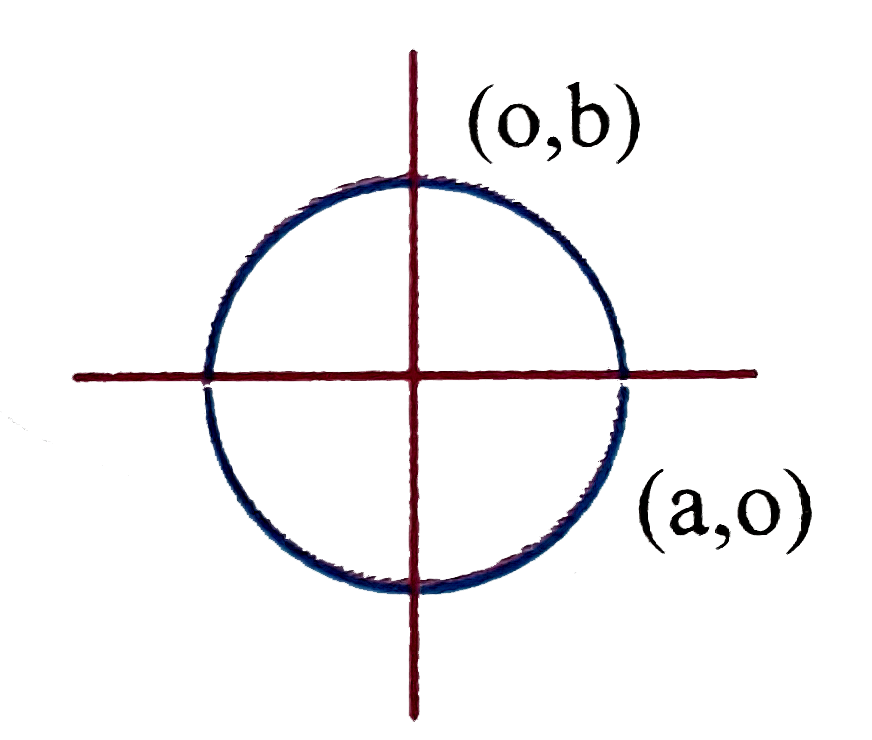The coordinate of a particle moving in a plane are given by x(t)=acos(pt)andy(t)=bsin(pt) where a,b(<a) and P are positive constants of appropriate dimensions . Then
The path of the particle is an ellipse
The velocity and acceleration of the particle are normal to each other at t=π2p
The acceleration of the particle is always directed towards a fixed position
The distance travelled by the particle in time internal t=0 to t=π2p is a
The correct Answer is:A, B, C
x2a2+y2b2=1,So the path is an ellipse
Vx=−apsinpt,Vy=bpcospt
ax=−ap2cosptay=−bp2sinpt
So →V−→a=0 when →V⊥→a
So a2p3sinpt.cospt−b2p3sinpt.cospt
⇒a2p3sinpt.cospt−b2p3sinpt.cospt
asa≠b So sin pt. cospt=0
⇒sinp2t=0⇒,2π⇒t=π2P−−
The motion is similar to motion of earth around sun So force always towards focus and hence acceleration. At t=0 particle is at (a,o)
At t=π2p particle is at (o,b)
So distance travelled along X axis is a not the actual distance, which is the length of the part of the elipse between (a,o) to (o,b) you can try out for distance by following method ds=√dx2+dy2
⇒ds=√1+(dydx)2⇒∫s0=∫0a√1+(dydx)2.(dx)

Topper's Solved these Questions
- BOOK - NARAYNACHAPTER - MOTION IN A PLANEEXERCISE - Level -V Passage15videos
MOTION IN A PLANE
- BOOK - NARAYNACHAPTER - MOTION IN A PLANEEXERCISE - Integer6videos
MOTION IN A PLANE
- BOOK - NARAYNACHAPTER - MOTION IN A PLANEEXERCISE - Level -V Single answer31videos
MOTION IN A PLANE
- BOOK - NARAYNACHAPTER - MECHANICAL PROPERTIES OF SOLIDSEXERCISE - LEVEL-II (H.W)24videos
MECHANICAL PROPERTIES OF SOLIDS
- BOOK - NARAYNACHAPTER - MOTION IN A STRAIGHT LINEEXERCISE - Level 2 H.W29videos
MOTION IN A STRAIGHT LINE
Similar Questions
Knowledge Check
- Question 1 - Select One or More
The coordinates of a particle moving in a plane are given by x(t)=acos(pt)andy(t)=bsin(pt) where a,b(<a)andp are positive constants of appropriate dimensions. Then
Athe path of the particle is an ellipse.Bthe velocity and acceleration of the particle are normal to each other at t=π/(2p).Cthe acceleration of the particle is always directed toward a focus.Dthe distance traveled by the particle in time interval t = 0 to t=π/(2p) is a. - Question 2 - Select One
The coordinates of a moving particle at any time t are given by x = ct and y = bt. The speed of the particle at time t is given by
A2t(c-b)B√(c2+b2)C2t√(c2+b2)D2t√(c2+b2) - Question 3 - Select One
The coordinates of a moving particle at any time t are given by x=ct and y=bt2. The speed of the particle is given by
A2t√b2−c2B√4b2t2+c2C2t(b+c)D2t(b−c)
The coordinates of a particle moving in XY-plane vary with time as x=4t2,y=2t. The locus of the particle is a : -
View SolutionThe coordinates of a particle moving in XY-plane very with time as x=4t2,y=2t. The locus of the particle is
View SolutionThe coordinates of a moving particle at any time t are given by x=αt3 and y=βt3. The speed of the particle at time t is given by
View SolutionThe coordinates of a moving particle at time t are given by x=ct2 and y=bt2. The speed of the particle is given by :-
View SolutionThe equations of motion of a particle P(x,y) on a plane are given by x=4+r.cost,y=6+r.sint, where t is time and r is constant . Its velocity at time t is
View Solution

